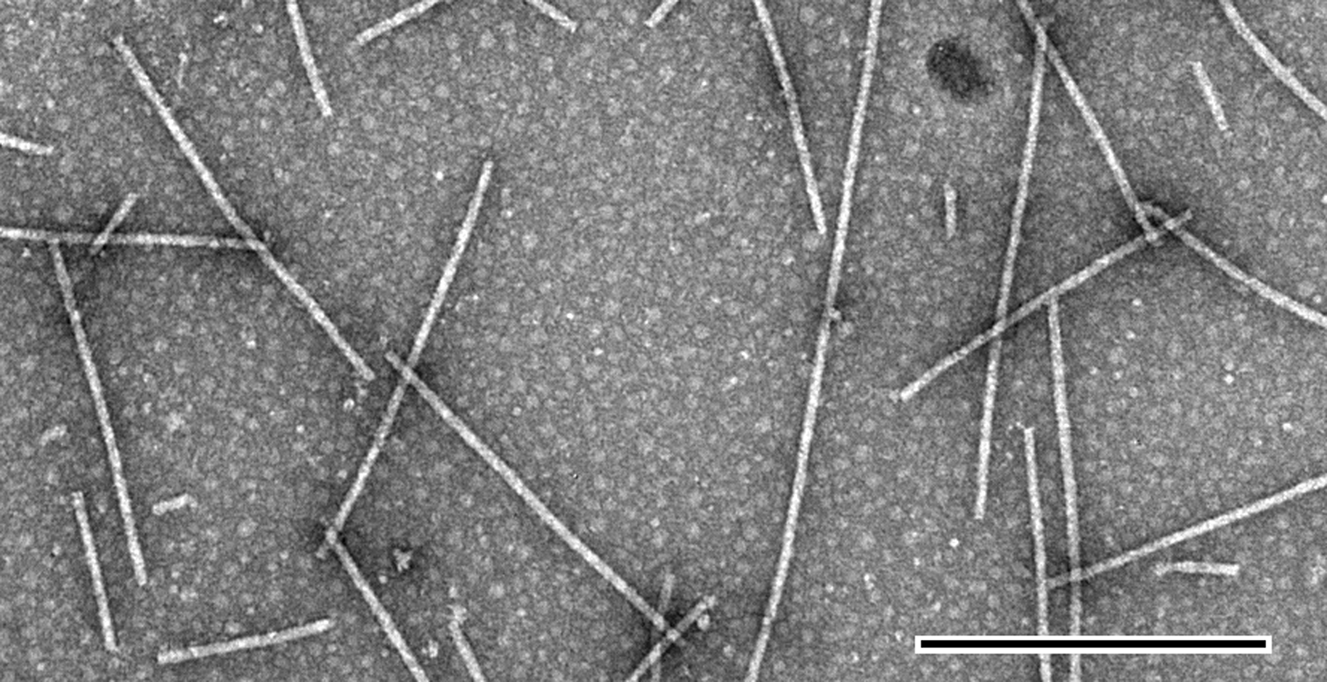Family: Alphaflexiviridae
Genus: Lolavirus
Distinguishing features
This genus includes a single species, Lolium latent virus. The genome of the single representative, Lolium latent virus (LoLV) has six ORFs (although the putative ORF6 is smaller than that found in members of other genera). The capsid protein is larger and the virions are longer than those of potexviruses, which they otherwise resemble. Notably two carboxy co-terminal forms of the capsid protein are found in essentially equimolar amounts in both extracts of infected plants and in purified virions (Vaira et al., 2008).
Virion
Morphology
LoLV virions are slightly flexuous filaments of 640 nm modal length and about 13 nm diameter (Figure 1. Lolavirus).
 |
|
Figure 1. Lolavirus. Negative-contrast electron micrograph of particles of an isolate of Lolium latent virus stained in phosphotungstic acid. The bar represents 500 nm (Courtesy of M.M. Dienelt). |
Physicochemical and physical properties
The LoLV virus forms a single band in caesium sulphate density gradients. Purified preparations show maximum absorption at 260 nm with a A260/280 ratio of 1.1 (corrected for light scattering).
Nucleic acid
LoLV virions contain a single molecule of linear single-stranded RNA of 7560 nt, excluding the 3′-poly(A) tail (Figure 2. Lolavirus).
Proteins
The only structural proteins are the two capsid protein (CP) isoforms, composed of 245 and 293 aa (28 and 32 kDa, respectively).
Carbohydrates
Both forms of the capsid protein are reported to be glycosylated (Vaira et al., 2012).
Genome organization and replication
The genomic RNA comprises six ORFs on the positive-strand, a 5′-UTR of 78 nt and a 3′-UTR of 40 nt, followed by a poly(A) tail (Figure 2. Lolavirus). ORF1 encodes the replication-associated protein (Rep). ORF2, ORF3 and ORF4 form the triple gene block (TGB). ORF5 encodes the CP. ORF6 encodes a putative protein of unknown function that shows limited similarity with nucleic acid-binding proteins encoded by ORF6 of allexiviruses and carlaviruses.
 |
|
Figure 2. Lolavirus. Genome organization of Lolium latent virus showing the relative positions of the ORFs and their expression products. Mtr, methyltransferase; Hel, helicase; AlkB, AlkB domain; RdRP, RNA-directed RNA polymerase; TGB, triple gene block; CP, capsid protein; NB, putative nucleic acid binding protein. |
Biology
Plants infected with LoLV exhibit either no symptoms or mild chlorotic flecking that coalesce to form chlorotic to necrotic streaking on the leaves. The virus is mechanically transmissible and Rhopalosiphum padi may be an inefficient vector (Huth et al., 1995).
Antigenicity
Particles are immunogenic. Rabbit antisera can have titers of 1/128 and 1/2048 in gel diffusion and EM decoration, respectively.
Derivation of names
Lola: from Lolium latent virus.
Species demarcation criteria
Since there is currently only a single species in the genus, species demarcation criteria are not yet defined, but, as delineated for other genera in the family, members of distinct species may have less than 72% nt identity (or 80% aa identity) in their CP or Rep genes.

